One of the biggest struggles for Modern Homesteaders is figuring out good time-management strategies.
One of the questions that I get frequently asked is: “How do you do it all? or How do you juggle all these things?” At the end of the day, I don’t claim to have it all figured out, and there are a lot of things I opt-out of and things I say no to.
There are a lot of different things that I do in my life to maintain good time management, and I’ve talked about many of them before:
- Practical Ways We Save Time on Our Homestead
- My Top 10 Homesteading Time Management Tips
- How to Cook From-Scratch With Limited Time
- How I (Don’t) Do It All
However, my #1 favorite secret weapon for keeping all of the balls in the air (most of the time) is my paper planner. This is kind of like my security blanket that helps me organize my homestead and it is never too far from my side.
I thought it would be fun to tell you about the ways I really put my planner to use around our homestead and for all the different aspects of our lifestyle.
Love to listen instead of read? Tune in to my podcast episode here:
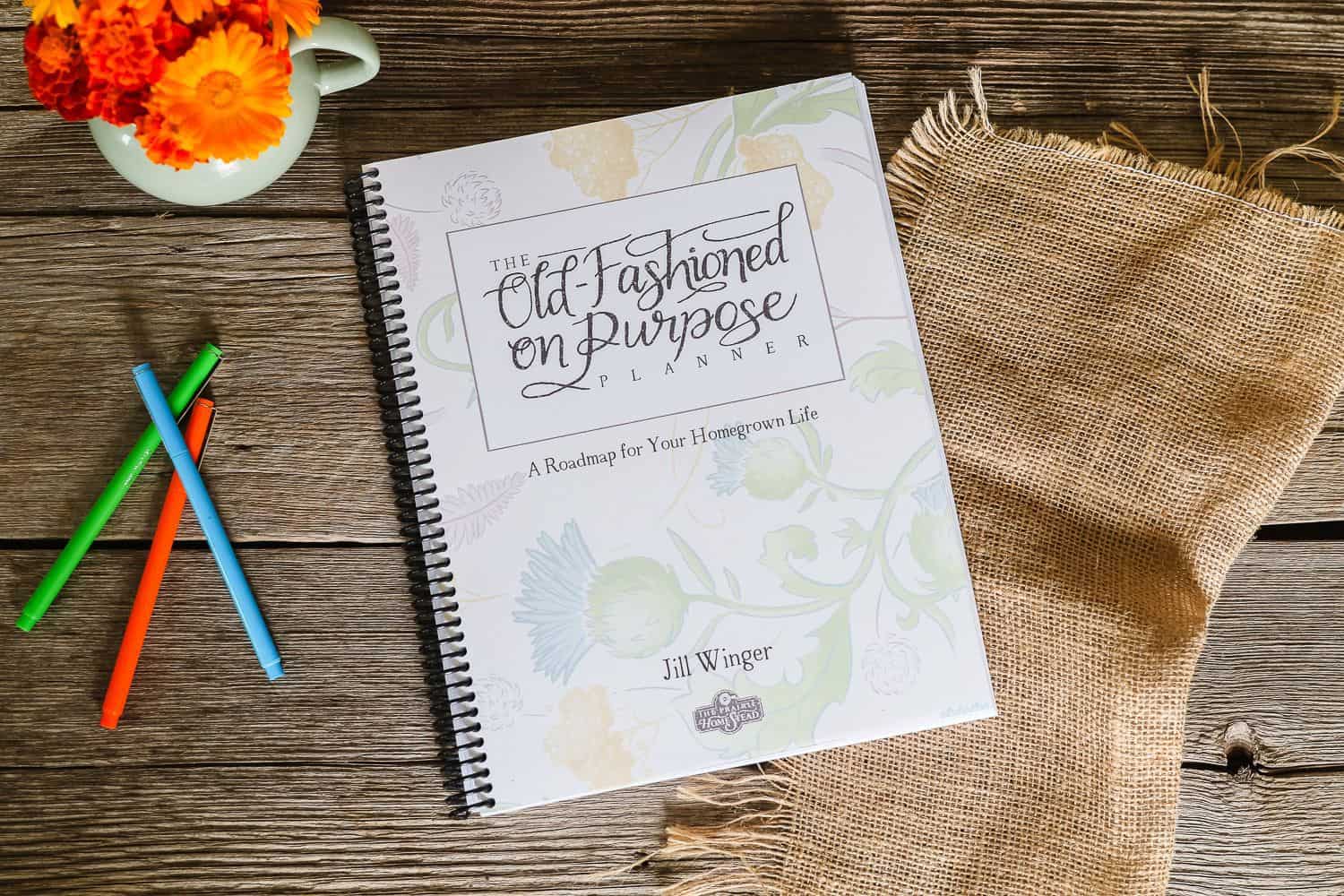
Best Tip: Planning Ahead to Help Stay Organized on The Homestead
There are a lot of little tricks that I have adopted over the years, but I would say one of the biggest pieces that help me organize my homestead is to PLAN AHEAD.
Honestly, what it all boils down to is I love a lot of things. There are a lot of aspects of life that are very exciting and motivating to me. I want to be involved with a lot and there are a lot of different avenues to go down. Planning ahead is one of the ways that I do everything without losing my marbles.
Over the years when trying to keep things organized on the homestead, there have been a lot of instances where I’m super glad that I like to plan ahead. One example that sticks out in my head is when we had our fair activities in the summer. The fair is quite the undertaking; we live at the fairgrounds for a week with a steer, the horses, the kids, and everything else involved with our fair activities. It is a lot, and for one week we live and breathe fair life.
This particular year, we were scheduled to host a horsemanship clinic on our property with only a few days in between the clinic and the times at fair. The clinics are super fun and we love putting them on but that means keeping things clean and getting things ready. We also cooked lunch for everyone and had company staying with us during the clinic.
We came home from the fair, and had to plan menus and there was plenty of cleaning to do. There were also some things with our businesses that we were getting ready to launch and school was right around the corner.
It was this kind of perfect storm of all things. Honestly, there were definitely a couple of days during that two or three-week stretch where I was like “there is a lot to do right now” but I never really got to the point where I was freaking out. This is because I PLAN AHEAD, I started by planning my rough menus for the horsemanship clinic before we went to the fair.
When you plan ahead, you don’t need to have everything completely ironed out, but it helps to just have some basic ideas planned out ahead of time. The process of thinking ahead about what I’m going to need and be prepared for is something I have learned over the years.
Planning ahead is a big deal for me. It may sound way too simplified but it really helps and I really believe that it is a big step to keep things organized.
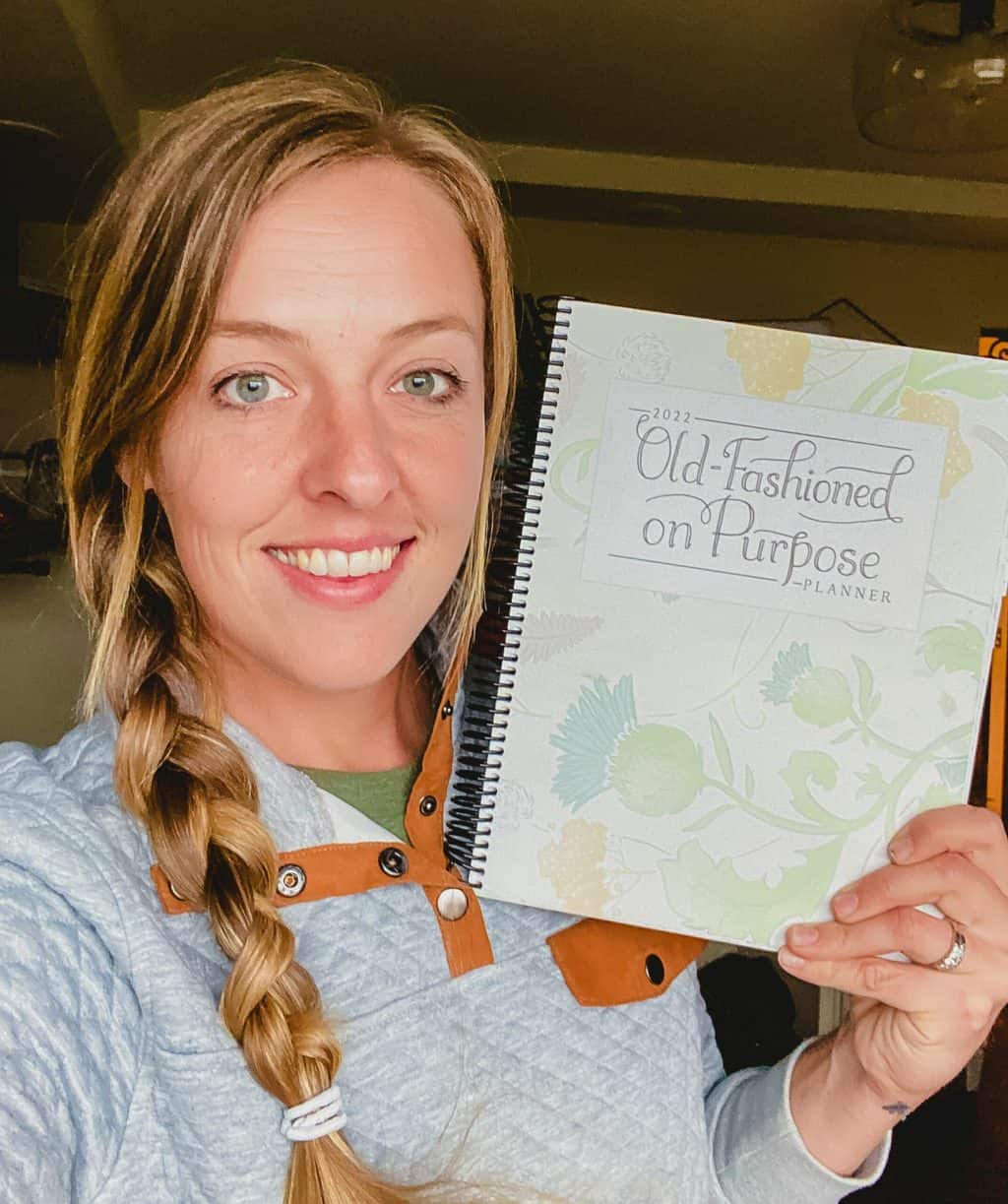
The Best Tool to Use to Organize Your Homestead
There are a million different styles and ways to organize your homestead and life. Some people really love digital stuff: they use spreadsheets, apps, and the calendar on their phone. There is nothing wrong with any of those options, you just have to figure out what works for you.
It really comes down to what you are going to use! You can have the best paper planner or the best app in the world but if it’s not something that feels simple for you to use, you’re not going to use it.
I personally prefer using a paper planner, as you all know by now that I have a little bit of an old-fashioned streak. I have tried the digital time management options, but they haven’t really felt right for me. I think it’s because when I write it down with a pen, things stick in my brain a little bit better. I don’t know if everyone is like that but that’s how I am.
Of course, having an online business and doing a lot on the computer requires me to track some things online. Even though I spend time on the computer, I have this phenomenon where I can type something out in the notes app, Google Drive, or on a Word document and it doesn’t stick in my brain. There have been more than a few times where I have been going through old documents on my computer and been like “Oh my gosh, I wrote this stuff three years ago and I don’t recall doing it”.
I just can’t seem to remember things that have been typed out as well. That is one of the reasons that a paper planner like the one I created (FOR homesteaders BY a homesteader), The Old-Fashioned On Purpose Planner, makes sense for me.
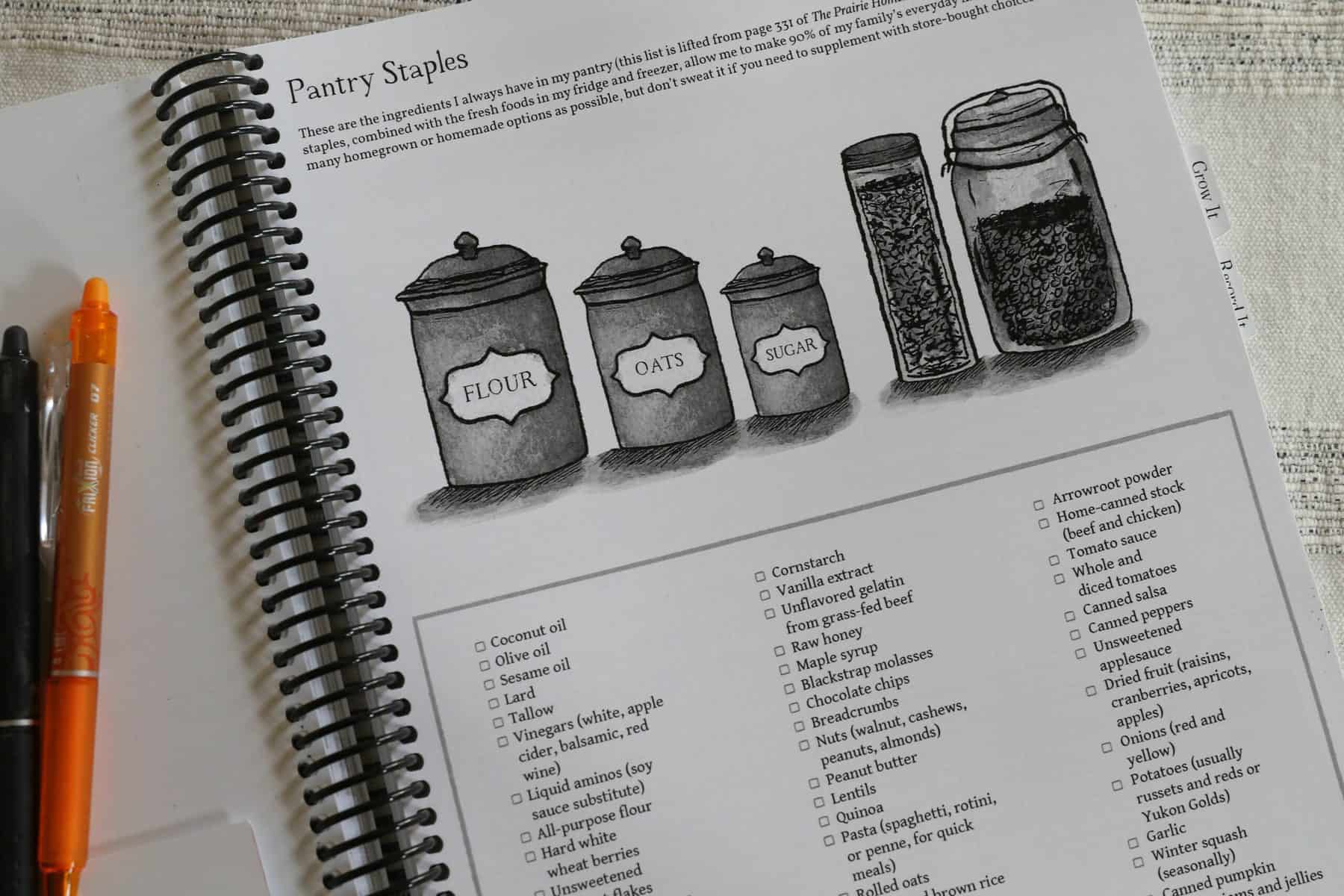
Using The Right Pens Matter…
Before I talk about my Old-Fashioned on Purpose Planner (and how to use planners in general for organizing homesteading stuff), let’s take a brief moment to talk about pens.
If you’ve never been into the world of paper planners, then allow me to explain: people can get really nerdy about pens. I am raising my hand as part of that club because the right pens really do matter. The wrong pen on a planner just doesn’t feel right.
Personally, I have high standards for pens, my favorite pens are erasable because I don’t like scribbling out in the planner. I realize a lot of the things I’m saying right now are making me sound a little crazy and that’s fine. I just had to be honest about how I don’t like scribble planners and I don’t like wrong pens (and I assume that hopefully, I’m not the only one…).
My favorite pens are called Frixion pens, they are available at most office supply stores. There is a multicolor pack that I usually buy. Recently, I discovered that the Frixion brand also makes erasable highlighters. This is not an ad for Frixion pens; I just really like them, go check them out or use whatever type of pen makes you happy. Whatever suits you is what you need!
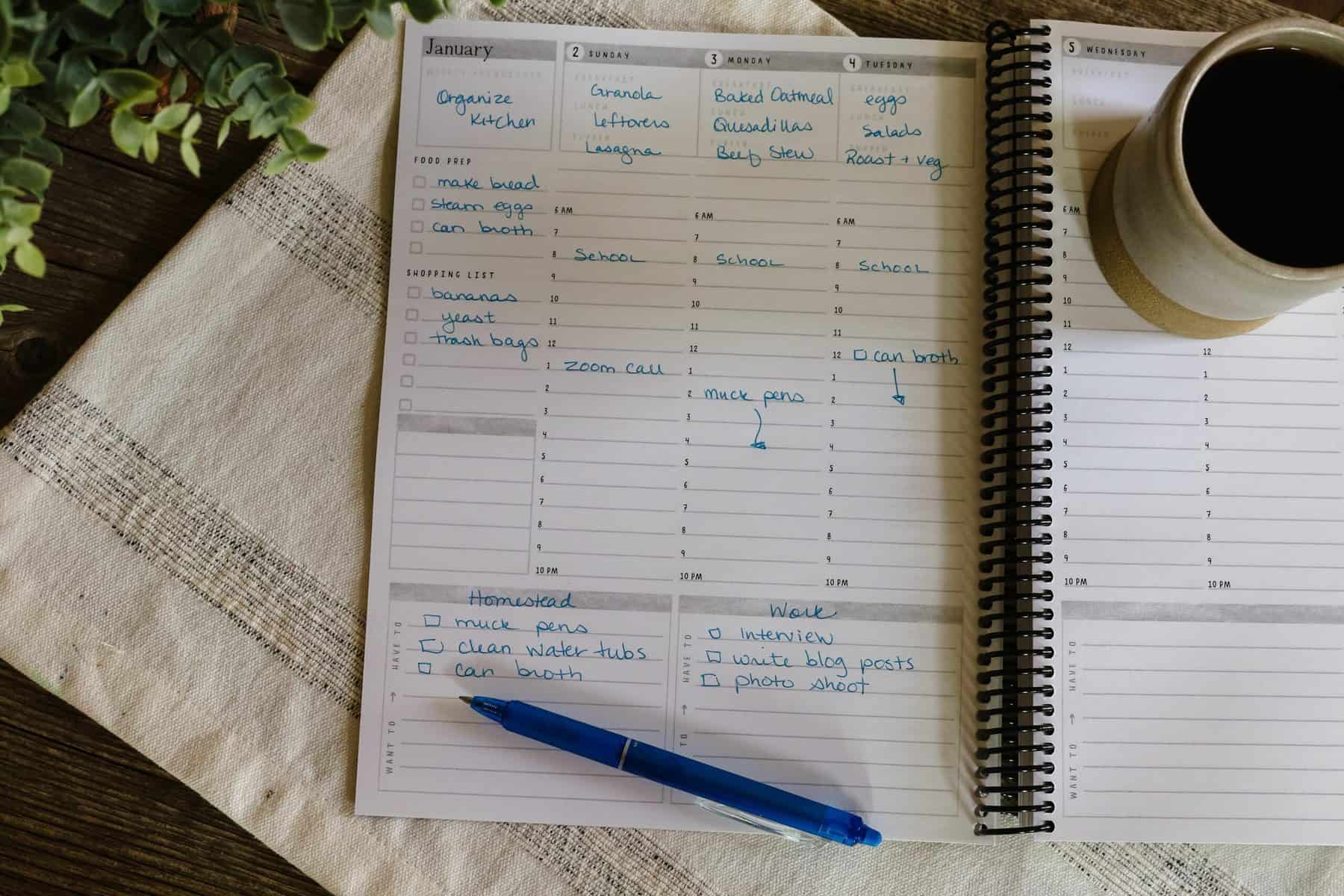
Ways I use a Planner to Organize My Homestead
There are a million planners and lots of ways to use a planner. I just wanted to take you through just some of the ways I use my planner for homesteading. These are just some of the little things I’ve come up with over the years that help me stay on track.
Using Weekly Spreads
First off for me, the weekly spreads are definitely the most used portion of my planner. Some really lean heavily on the month at glance, that’s cool I just don’t. I have found that I don’t look at them as much as I do my weekly spreads. My personal preference is a planner that has each day of the week broken down into hourly blanks.
Hourly Breakdowns are Important
In the past, I have purchased planners where Monday was just one big white box of space. The empty space seemed harder for me and I always had to know when specific times were. I found it easier to plan for the different things that happen throughout the day to have a planner that has the hours written in.
Use Time Blocking to Organize Your Homestead
The easiest way for me to use those hourly blanks is as a time block for tasks. I like to use my highlighters or sometimes I’ll just use my pen and draw a bracket around specific time frames I’m blocking for tasks.
Putting tasks together within the time blocks is something that I try to do that helps me. If I am constantly switching tasks, bouncing around throughout the day, and doing things in 15-minute increments it takes more time. When I batch things whether it’s recording podcasts, cooking, meal prep, or cleaning the house it is just more efficient. This is where I will bracket those tasks out into my planner.
When to Add Items and Checkboxes
At the beginning of each week, usually Sunday evening or Monday morning I will open up my weekly spread and fill out the standing appointments. This includes recurring calls that I have every week, soccer practices twice a week and I like to add in school. These are not really reminders, they are more like placeholders to organize your homestead life.
If you look at my planner right you will see that I draw my own little check box in front of each item. I check them off as they get finished. I guess I have this insatiable need to check things off and yes I know that sounds weird. Everything I put in my planner has a checkbox and hets checked off. It doesn’t matter if it is soccer practice, school for the day, working out, or making this supper.
Menu Planning Using a Planner to Organize Homestead Life
I’m not a huge super organized menu planner but at the end of each day around 6 o’clock, we eat supper. In the weekly spread in my planner around the 6 o’clock hour, I like to write what we are eating that day. Sometimes it is just two or three days in advance but even that is enough for me to know what I need to be thinking about. This helps give me a visual representation of what the plan is and also what food prep needs to be done.
A great example is one Saturday we were preconditioning our cattle. This is a big day, there are a lot of people helping and I help cook the meal for preconditioning. For Friday afternoon, I wrote in (with my little checkbox): ‘prep the food for preconditioning’. I have that built-in because it is very easy to look at that blank Friday spot and forget.
Adding Your To-Do Lists to Organize the Homestead
On the weekly spread, I like to have a work To-Do List and a personal To-Do List. At the beginning of the week, I write down all the personal and work stuff I need to do. You might not be splitting your life into home tasks and business tasks but you can split it up any way you want.
An example of what you will find on my personal To-Do List is getting the onions and cabbage dealt with, cleaning the playroom, and drying more tomatoes. On my work To-Do List, you will find things like: writing the newsletter, record podcasts, and write a blog post.
Once these lists are complete I can take those items and insert them into the days as I’m planning. If I leave the things down in the to-do boxes without assigning them to a day I don’t hold myself accountable to do them.
![]()
Habit Tracking in Your Planner
Another thing that I do is take a sticky note and add different habits I am working on. This can include things like working out, feeding the sourdough, or remembering to water the seedlings in the basement. I will make little check boxes on the sticky note and color them in or check them off as I go.
We did a challenge with some friends of ours once where the challenge was to run a mile a day. I needed to keep track of 31 miles in January so I made a sticky note with 31 checkboxes every time I ran a mile I would color in a box.
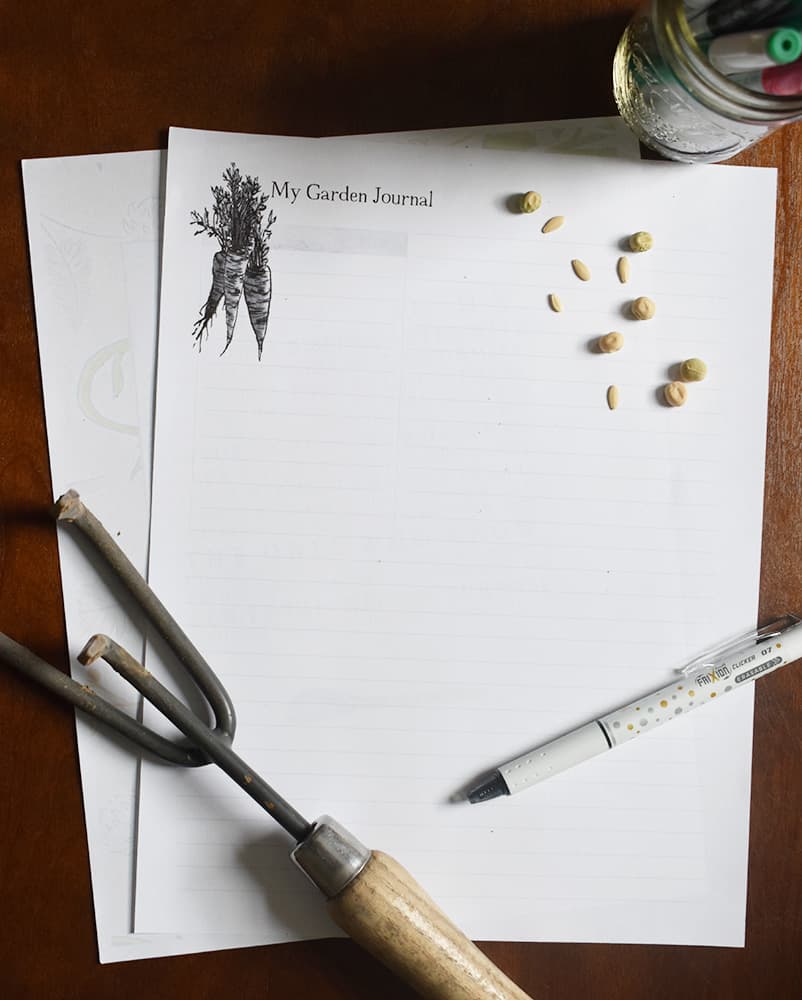
The Most Important Pages are the Back Pages
I love a planner with a lot of blank pages or helpful pages in the back. The back portion of my planner gets used more than any other part. I keep my planners, and they don’t get thrown away at the end of the year.
The reason I don’t throw them away is that there have been many times where I need to look back at something. This section ends up being a record of our lives. It has a lot of details of what has happened and I find it is really handy to keep around. The back of my planners are used as a way to keep track of any other details about our life or year.
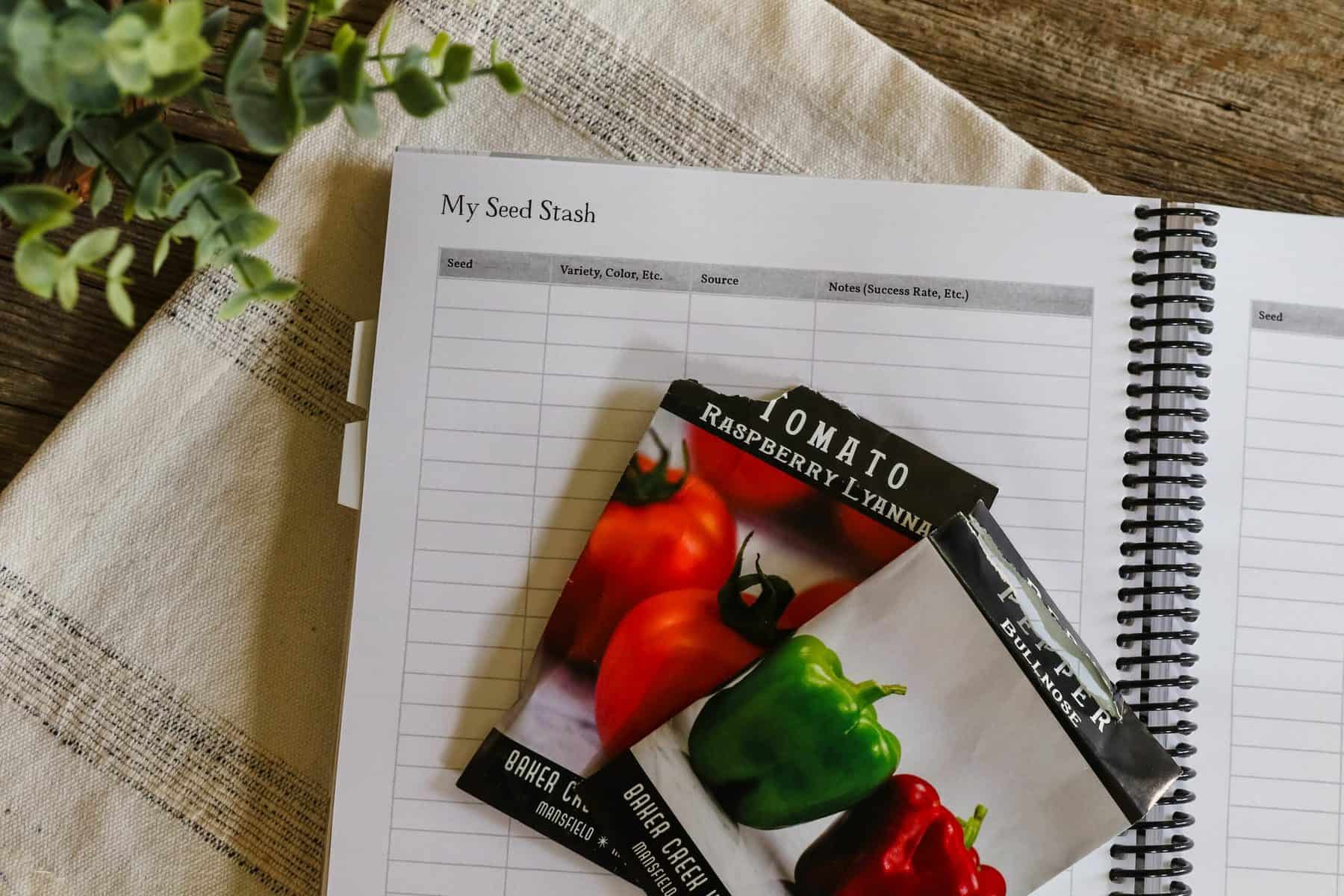
Some ways that I use those back pages for organizing my homestead include:
- Yearly Goals:
Usually, the week between Christmas and New Year I sit down with coffee, a candle, my favorite pen and I work on goals for the year. These goals get broken up into homestead goals, business goals, and personal goals. One year, some of our homesteading goals were to build a greenhouse and to put up the hail netting in the garden. A personal goal might be to work out more. I remember to look at those goals. I don’t look at them every week, sometimes I forget to even look at them once a month but just having that moment at the beginning of the year to write things down is a big deal for me. This really seems to make a difference with how my year will start. - Garden Journal:
Some of those back pages I like to use to keep garden notes on. We have a raised beds, but this would work even if you have an in-ground garden. One thing I always do is forget if I don’t write down what I put in the raised beds. There are 20 beds and they’re all pretty uniform so I make a simple sketch of my beds and then I number them. On the other side of the page, I write the number and what is planted there. I wrote little notes so that way I can do some crop rotation and I don’t have to worry about putting things in the wrong bed. - Book List:
I like to create a list of books to read at the beginning of every year. As the year goes keep track of the books that I have finished and add more. If I read one that’s not on the list I add it, this is kind of a fun way to track what I’ve been reading throughout the year. - Animal Records:
The back pages of my planner are also where I keep track of animal breeding and health records. This is really helpful to look back on to determine dates and what comes next. - Big Project Lists:
If I have a big project, I like to break it down in the back of the planner just because if I put it on scratch paper a lot of the time I find that I lose it. Breaking down a project is when I do this thing where I write out the main steps that need to happen and then I break those into baby steps. Learn more about how I break down a project in my How to Set Homestead Goals article.
I really depend heavily on my planner to help organize my homestead and life. In the past, I have limped along for a very long time with other planners. I have used a variety over the years and they have worked okay, but they were not quite exactly what I wanted.
This is why I decided to make my own, The Old-Fashioned On Purpose Planner.
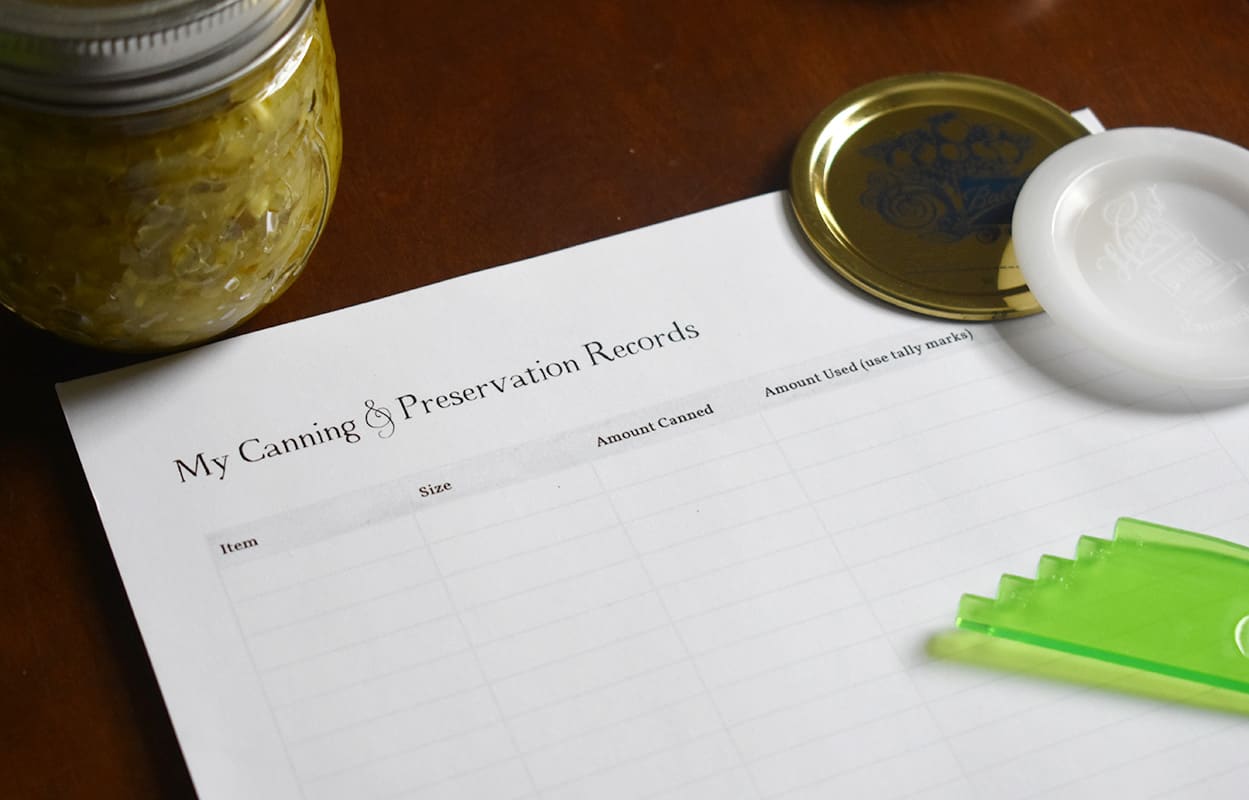
The Old-Fashioned On Purpose Planner
Planners truly have been very pivotal to my success as a homesteader. I have not yet found a planner that actually understands what we need to have success and stay organized while homesteading.
The Old Fashioned on Purpose Planner is a real paper planner with spiral binding. It is and has all the things I described earlier! Everything I have explained about how I use my older planners, we created in the Old-Fashioned On-Purpose Planner.
Here’s a quick glance at what I have included in the Old-Fashioned on Purpose Planner:
- Designed to simplify the life of a busy person who’s trying to keep all the balls in the air.
- Helps streamline all aspects of your lifestyle, manage all the projects, & master new skills. ?
- Quick-reference kitchen guides, areas for daily meal planning, & cheatsheets to save time & simplify in the garden, kitchen, & more.
- A 253-page, spiral-bound, 15-month planner dated for 2022, made & printed in the USA.
- Dated weekly & monthly spreads
- Durable cover with section dividers & tabs
- Monthly catch-all lists
- Inventory & tracking pages
Learn more about my Old-Fashioned on Purpose Planner here. There’s a video-glance at the planner pages and even more details on what type of pages are included in the planner.
I’m really excited about how it turned out and I hope it helps you keep your homestead and life organized like it does for me!
Regardless of what type of planner you decide to use, I truly believe that actively using a planner (whether digital or print) makes a huge difference in keeping both the homestead and our lives organized. It might take some persistence on your part at first to get used to actively using a planner, but once you make it a habit in your life, you won’t regret it.
More Homesteading Tips:
- How to Homestead When You’re Feeling Overwhelmed
- How to Cultivate Community While Homesteading
- How to Start a Homestead From Scratch
- About Homesteading Stereotypes…
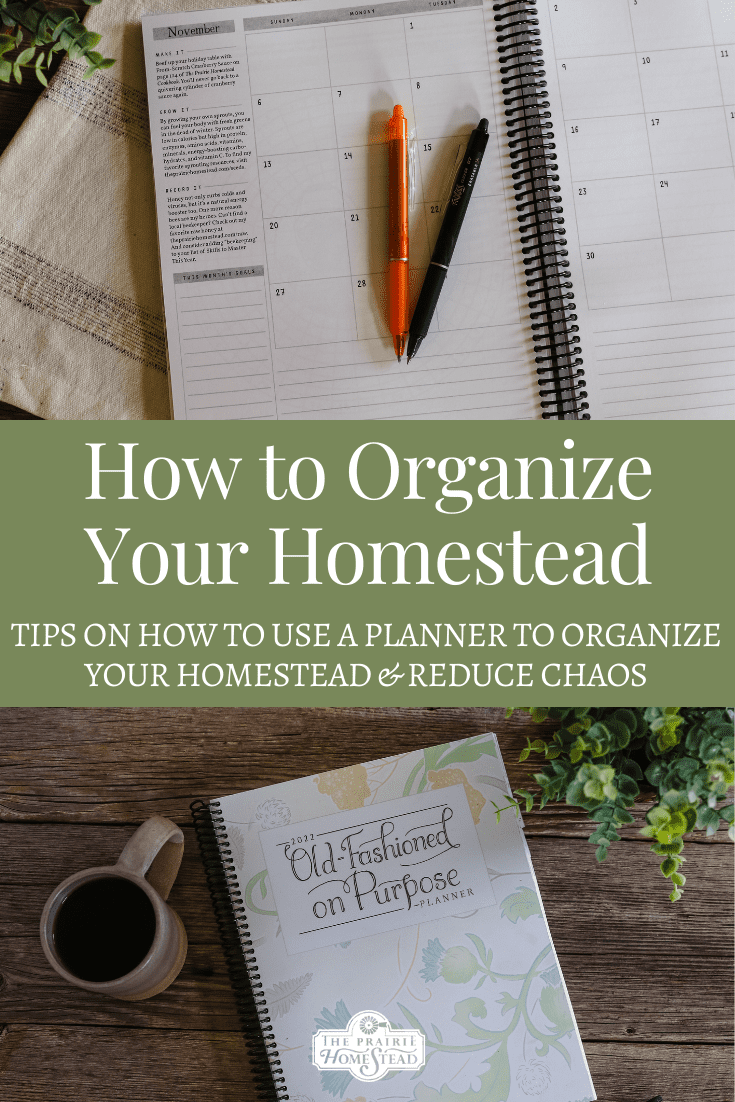
The post How to Organize Your Homestead with a Planner appeared first on The Prairie Homestead.
Via Gardening http://www.rssmix.com/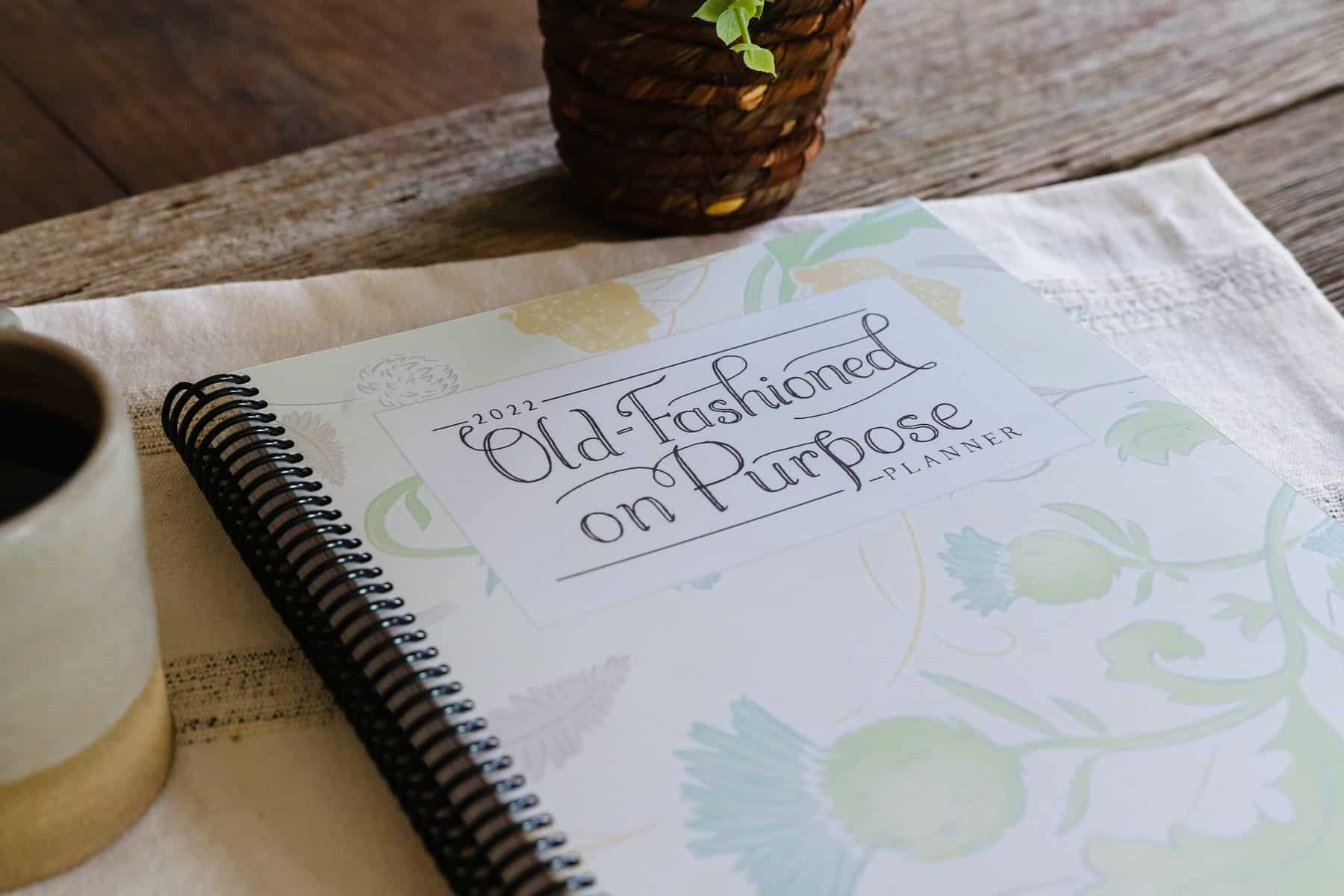
No comments:
Post a Comment